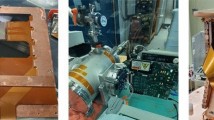Abstract
We present the noise performance of high electron mobility transistors (HEMT) developed by CNRS/C2N laboratory. Various HEMT’s gate geometries with 2 pF to 230 pF input capacitance have been studied at 4 K. A model for both voltage and current noises has been developed with frequency dependence up to 1 MHz. These HEMTs exhibit low dissipation, excellent noise performance and can advantageously replace traditional Si-JFETs for the readout of high impedance thermal sensor and semiconductor ionization cryogenic detectors. Our model predicts that cryogenic germanium detectors of 30 g with 10 eV heat and 20 eV\(_\mathrm{ee}\) baseline resolution are feasible if read out by HEMT-based amplifiers. Such resolution allows for high discrimination between nuclear and electron recoils at low threshold. This capability is of major interest for coherent elastic neutrino scattering and low-mass dark matter experiments such as Ricochet and EDELWEISS.






Similar content being viewed by others
References
E. Armengaud et al., Performance of the EDELWEISS-III experiment for direct dark matter searches. J. Instrum. 12(08), P08010 (2017). https://doi.org/10.1088/1748-0221/12/08/P08010
E. Armengaud et al., Final results of the EDELWEISS-II WIMP search using a 4-kg array of cryogenic germanium detectors with interleaved electrodes. Phys. Lett. B 702, 329–335 (2011). https://doi.org/10.1016/j.physletb.2011.07.034
L. Hehn et al., Improved EDELWEISS-III sensitivity for low-mass WIMPs using a profile likelihood approach. Eur. Phys. J. C 76, 548 (2016). https://doi.org/10.1140/epjc/s10052-016-4388-y
R. Agnese et al., (SuperCDMS Collaboration), Results from the super cryogenic dark matter search experiment at Soudan. Phys. Rev. Lett. 120, 061802 (2018). https://doi.org/10.1103/PhysRevLett.120.061802
R. Agnese et al., (SuperCDMS collaboration), Search for low-mass dark matter with CDMSlite using a profile likelihood fit. Phys. Rev. D 99, 062001 (2019). https://doi.org/10.1103/PhysRevD.99.062001
G. Angloher et al., Results from 730 kg days of the CRESST-II dark matter search. Eur. Phys. J. C 72, 1971 (2012). https://doi.org/10.1140/epjc/s10052-012-1971-8
G. Angloher et al., Results on light dark matter particles with a low-threshold CRESST-II detector. Eur. Phys. J. C 76, 25 (2016). https://doi.org/10.1140/epjc/s10052-016-3877-3
D.S. Akerib et al., Results from a search for dark matter in the complete LUX exposure. Phys. Rev. Lett. 118, 021303 (2017). https://doi.org/10.1103/PhysRevLett.118.021303
X. Cui et al., (PandaX-II Collaboration), Dark matter results from 54-ton-day exposure of PandaX-II experiment. Phys. Rev. Lett. 119, 181302 (2017). https://doi.org/10.1103/PhysRevLett.119.181302
E. Aprile et al., (XENON Collaboration), Dark matter search results from a one ton-year exposure of XENON1T. Phys. Rev. Lett. 121, 111302 (2018). https://doi.org/10.1103/PhysRevLett.121.111302
E. Armengaud et al., (EDELWEISS Collaboration), Searching for low-mass dark matter particles with a massive Ge bolometer operated above ground. Phys. Rev. D 99, 082003 (2019). https://doi.org/10.1103/PhysRevD.99.082003
Q. Arnaud et al., Optimizing EDELWEISS detectors for low-mass WIMP searches. Phys. Rev. D 97, 022003 (2018). https://doi.org/10.1103/PhysRevD.97.022003
R. Agnese et al., Projected sensitivity of the SuperCDMS SNOLAB experiment. Phys. Rev. D 95, 082002 (2017). https://doi.org/10.1103/PhysRevD.95.082002
Q. Arnaud et al., First results from the NEWS-G direct dark matter search experiment at the LSM. Astropart. Phys. 97, 54–62 (2018). https://doi.org/10.1016/j.astropartphys.2017.10.009
A. Aguilar-Arevalo et al., Search for low-mass WIMPs in a 0.6 kg day exposure of the DAMIC experiment at SNOLAB. Phys. Rev. D 94, 082006 (2016). https://doi.org/10.1103/PhysRevD.94.082006
R. Agnese et al., First dark matter constraints from a SuperCDMS single-charge sensitive detector. Phys. Rev. Lett. 121, 051301 (2018). https://doi.org/10.1103/PhysRevLett.121.051301
J. Tiffenberg et al., Single-electron and single-photon sensitivity with a silicon skipper CCD. Phys. Rev. Lett. 119, 131802 (2017). https://doi.org/10.1103/PhysRevLett.119.131802
D. Akimov et al., (COHERENT Collaboration), Observation of coherent elastic neutrino-nucleus scattering. Science 357, 1123–1126 (2017). https://doi.org/10.1126/science.aao0990
J. Billard et al., Coherent neutrino scattering with low temperature bolometers at Chooz reactor complex. J. Phys. G Nucl. Part. Phys. 44, 105101 (2017). https://doi.org/10.1088/1361-6471/aa83d0
G. Angloher et al., (NUCLEUS Collaboration), Exploring CEvNS with NUCLEUS at the Chooz nuclear power plant. https://arxiv.org/abs/1905.10258
G. Agnolet et al., Background studies for the MINER coherent neutrino scattering reactor experiment author links open overlay panel. Nucl. Instrum. Methods A 853, 53 (2017). https://doi.org/10.1016/j.nima.2017.02.024
Q. Dong et al., Ultra-low noise high electron mobility transistors for high-impedance and low-frequency deep cryogenic readout electronics. Appl. Phys. Lett. 105, 013504 (2014). https://doi.org/10.1063/1.4887368
Y. Jin et al., Ultra-low noise HEMTs for deep cryogenic low-frequency and high-impedance readout electronics, in 12th IEEE International conference on solid-state and integrated circuit technology (ICSICT) (2014). https://doi.org/10.1109/ICSICT.2014.7021379
http://interfet.com/AppSelector/Low-Noise-Hi-Gain-Amplifier/
A. Phipps et al., An HEMT-based cryogenic charge amplifier for sub-Kelvin semiconductor radiation detectors. J. Low Temp. Phys. 184, 897 (2016). https://doi.org/10.1007/s10909-016-1475-2
B. Censier et al., EDELWEISS read-out electronics and future prospects. J. Low Temp. Phys. 167, 645 (2012). https://doi.org/10.1007/s10909-012-0568-9
A. Phipps et al., A HEMT-based cryogenic charge amplifier with sub-100 eVee ionization resolution for massive semiconductor dark matter detectors. Nucl. Inst. Methods Phys. Res. A 940, 181 (2019). https://doi.org/10.1016/j.nima.2019.06.022
X. de la Broise et al., Cryogenic low noise and low dissipation multiplexing electronics, using HEMT+SiGe ASICs, for the readout of high impedance sensors: new version. Nucl. Inst. Methods Phys. Res. A 787, 54 (2015). https://doi.org/10.1016/j.nima.2014.11.019
Acknowledgements
This work was supported by the LabEx Lyon Institute of Origins (ANR-10-LABX-0066) of the Universite de Lyon in the framework “Investissements d’Avenir” (ANR-11-IDEX-00007), by the Cross-Disciplinary Program on Instrumentation and Detection of CEA in the framework of the BASKET project and has received funding from the European Research Council (ERC) under the European Union’s Horizon 2020 research and innovation program under Grant Agreement ERC-StG-CENNS 803079. We thank EDELWEISS and Ricochet collaborations for their help and useful discussion in performing this work.
Author information
Authors and Affiliations
Corresponding author
Additional information
Publisher's Note
Springer Nature remains neutral with regard to jurisdictional claims in published maps and institutional affiliations.
Rights and permissions
About this article
Cite this article
Juillard, A., Billard, J., Chaize, D. et al. Low-Noise HEMTs for Coherent Elastic Neutrino Scattering and Low-Mass Dark Matter Cryogenic Semiconductor Detectors. J Low Temp Phys 199, 798–806 (2020). https://doi.org/10.1007/s10909-019-02269-5
Received:
Accepted:
Published:
Issue Date:
DOI: https://doi.org/10.1007/s10909-019-02269-5




